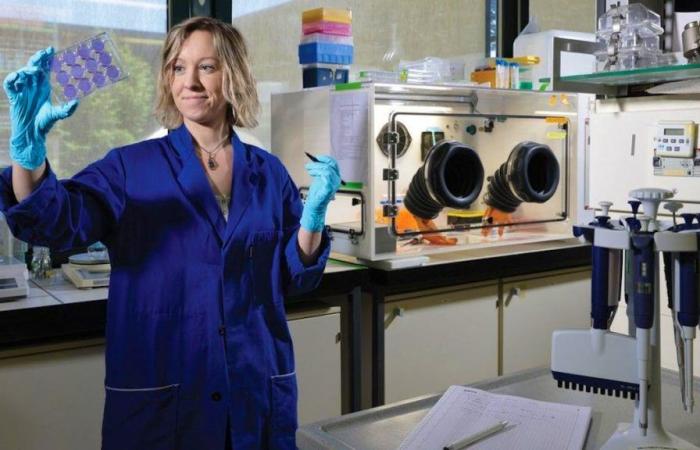Researcher Shannon David in the Environmental Virology Laboratory at EPFL.
EPFL/Alain Herzog
An EPFL study provides new explanations of the complex relationships that exist between viruses and bacteria in the human body. Every healthy person carries all kinds of bacteria, whether on the skin, in the intestines, the nose or the mouth. And when we catch the flu virus, it coexists with the bacteria lodged in our respiratory tract.
But what happens when an individual releases the virus into the air by sneezing, coughing, or simply talking? The relationship of the virus with bacteria outside the body has until now been little studied, hence the subject of this research carried out within the Environmental Virology Laboratory (LEV), in collaboration with scientists from the Faculty of the natural, architectural and built environment (ENAC), the ETHZ and the University of Zurich. Their results have just been published in the Journal of Virology.
They protect the virus
Certain bacteria allow viruses to stabilize and survive longer in the intestines. On the same principle, Shannon David, researcher in the LEV Laboratory, wondered whether bacteria in the respiratory tract could have the same protective function outside the body. And the answer is yes.
To demonstrate this, she and her colleagues conducted two types of laboratory experiments. In the first, scientists reproduced droplets similar to those produced when you sneeze. They were placed on a flat surface and exposed to indoor air until they dried. Some droplets contained only the flu virus, while the others were mixed with some respiratory tract bacteria.
The scientists measured the infectious viral load of these two groups of droplets over time. The results were very clear: when the virus was isolated, it disappeared almost completely (99.9%) after 30 minutes. But accompanied by bacteria, his infectious viral load was 100 times greater after the same exposure time and he could survive for several more hours.
Still infectious an hour later
In the second experiment, the infectious viral load was measured in small particles transmitted in the air like those exchanged when two people talk to each other. Here too, the virus alone was no longer infectious after 15 minutes. But accompanied by bacteria, it was still present for an hour. Among the bacteria identified in the respiratory tract, Staphylococcus aureus et Streptococcus pneumoniae were those that most favored the viral spread of influenza.
Their microscopic observations also provided a better understanding of how the bacteria protects the virus. “The droplet containing the bacteria tends to be flatter. This phenomenon accelerates the evaporation process and leads to faster crystallization of the salt in the droplet, allowing the virus to live longer. Particularly in dry environments, like in winter when the heaters are on,” explains Shannon David.
Individuals more contagious than others
“These new data are important because they provide an additional piece to the puzzle of respiratory diseases. And to better understand why the virus travels so well from one person to another. The role that respiratory bacteria play outside the body was until now unknown,” explains Shannon David. Several associated areas of research will benefit from this new data. They could, for example, be integrated into public health studies.
“Today, simulation models which assess the risk of exposure to an infection in a closed place do not yet take into account the protective role of these bacteria over viruses. This means they are probably underestimating the risk of infection.” This new knowledge could also make it easier for researchers to identify individuals who are likely to produce a higher infectious viral load because they carry more protective bacteria in their airways.






